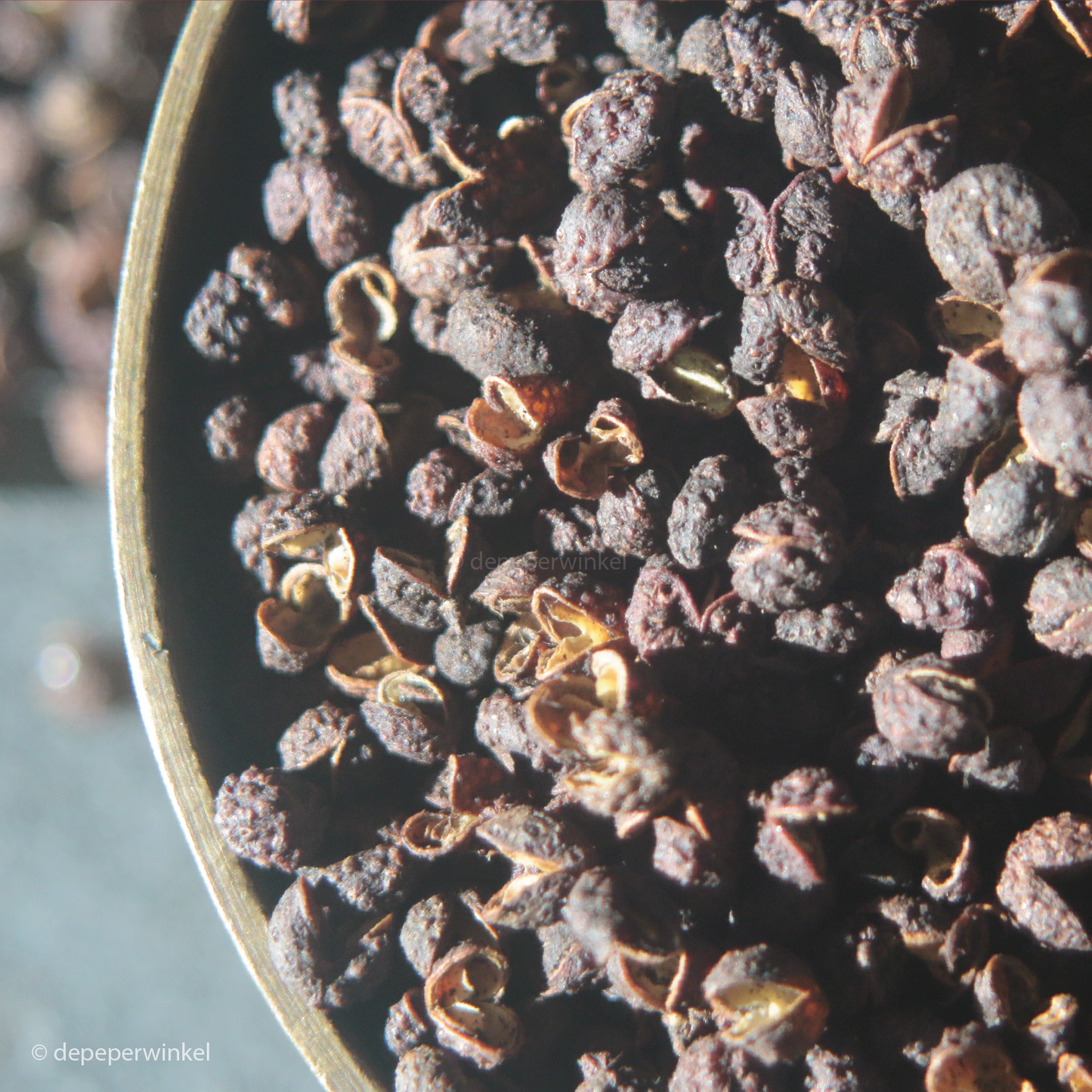depeperwinkel
Ray Timur
Ray Timur
Unable to load availability for pickup
Raye timur or timut pepper grows wild in large parts of the Himalayas and in India's Eastern Ghats. It is the berry of the Zanthoxylum armatum, a Sichuan pepper. The dark brown berry is sharp and has an unmistakable grapefruit aroma.
This Szechuan pepper is called timur in Nepal and India, elsewhere also timut or Nepalese mountain pepper. The fruit has been collected by indigenous people for centuries for medicinal use - including against flatulence. Nowadays, Timur is increasingly being picked for its mildly pungent sharpness and unmistakable citrus flavour, in this case grapefruit. or pomelo. The citrus flavor becomes stronger and sweeter when the pepper is heated - roasted.
The Zanthoxylum armatum on which this pepperberry grows is a shrub with vicious spines. The shrub bears small yellow flowers that develop into fruits that quickly turn pale red and eventually become dark red. The bunches of berries are harvested from the first week of October until well into November.
The timur is found in the warmer valleys in the Himalayas at altitudes of 1000 to 2100 meters. It is one of the few spices that grow at such altitudes. The Raye timur is mainly picked in the Bajura and Myagdi regions. It grows in abundance, but the harvest is small-scale. In India the species is threatened by excessive, uncontrolled picking, but this is not the case in Nepal.
The unique sharpness experience of sanshol
Characteristic of all Zanthoxylum peppers, and therefore also of the Szechuan pepper, is the tingling you experience on the tip of your tongue due to a substance in the pepper called sanshool, named after the Japanese sanshō. The pungency is caused by the amides in the peel of the fruit: α-, β-, γ- and δ-sanshool, α hidroxy sanshool and β-hidroxy sanshool. γ sanshool and α hidroxy sanshool are mainly responsible for the anesthetic effect. The amount of α-hidroxy-sanshool in the berries can amount to (more than) 50 ‰ of the dry weight, of γ sanshool around 5 ‰.
The tingling is accompanied by a slight numbness, jokingly compared to tasting a 9 volt battery. One single berry is enough to experience that! This somatosensation, stimulation by touch, has been used as an anesthetic in traditional medicine in Asia for centuries. The effect is very complex and the subject of extensive studies. Hydroxy-α-sanshol in particular is said to cause the tingling, and there are certain parallels with the pungency sensation of capsaicin, the pungent substance in chili peppers, but also with menthol and mustard oil.
Smell and taste
In Raye timur the scent of grapefruit is prominent, so much so that you have to be careful with the dosage. This is an anthology just from the broad taste palette:
- D-limonene * (dipentene), sweet orange flavor, modestly present in nutmeg, mace and cardamom,
- linalol *, responsible for the fresh floral scent
- methyl cinnamate *, the taste of strawberry, but the smell balsamic,
-
β-pinene, woody pine odor, as in cumin, pine, juniper and hemp,
- myrcene, as in laurel and cloves
- sabinene, responsible for the woody, camphoraceous flavor of black pepper, among others
- carvotan acetone, also minty, as in angelica,
- the bitter terpinol *, - mainly found in the seeds - as in cranberries.
The oils marked with a star are dominant in aroma and taste.Feel free to combine timur with any of the spices mentioned above, and in general with products that go well with citrus such as crustaceans and shells, white fish, salmon, white butter sauces, veal, pork and duck. Can be eaten raw or added at the last minute, and is delicious in vegetable salads and desserts or with fruit.
Usage
Crush the fruit to release the seeds. These are easier to grind than the seed pods, which are best ground. Just like the whole berries (with seeds).
In the kitchens of Tibet, Nepal and Buthan, timur is used in chutneys and pickles, among other things. Famous dishes from Nepalese cuisine that use timur are momo (a dumpling) and thupka (a noodle soup. In Indian cuisine, the timur is called the 'mirchi berry', it could be. Mirchi is the Hindi- name for all types of pepper, from black pepper to chili pepper, Bhut Jolokia and Naga Jolokia (raja mirch). The pepper is used in a nutritious winter soup called hag and in chutneys such as dunkcha.
Features:
- 100% berries of Zanthoxylum armatum
- wild picking, hand picked
- origin: Bajura and Myagdi regions, Nepal
Assortment
- available in glass, stand-up pouch and test tube
- glass jar contains 30 grams
- stand-up pouches with a capacity of up to 30 to 300 grams
- available in 10 ml test tube
- larger quantities on request
Gift packaging
- the jar is available in a tasteful gift packaging, consisting of a cube box filled with black tissue paper
- for an overview of our gift packaging, please refer to the gift packaging section
General advice
- Raye timur, like Mac Khen and Ma Khaen, is a versatile Szechuan pepper that can be used both raw and roasted. The difference ? Raye timur tastes like grapefruit, Mac Khen and Ma Khaen like orange peel.
Save:
- keep your raye timur in closed packaging
- preferably store in a dark, dry and cool place
- best before December2027 (12/27)
- this expiration date is an indication
Want to know what Raye timur tastes like ?
Batch number
The batch number helps us trace which supply an item comes from. It is stated on the packing slip and the invoice
Share









